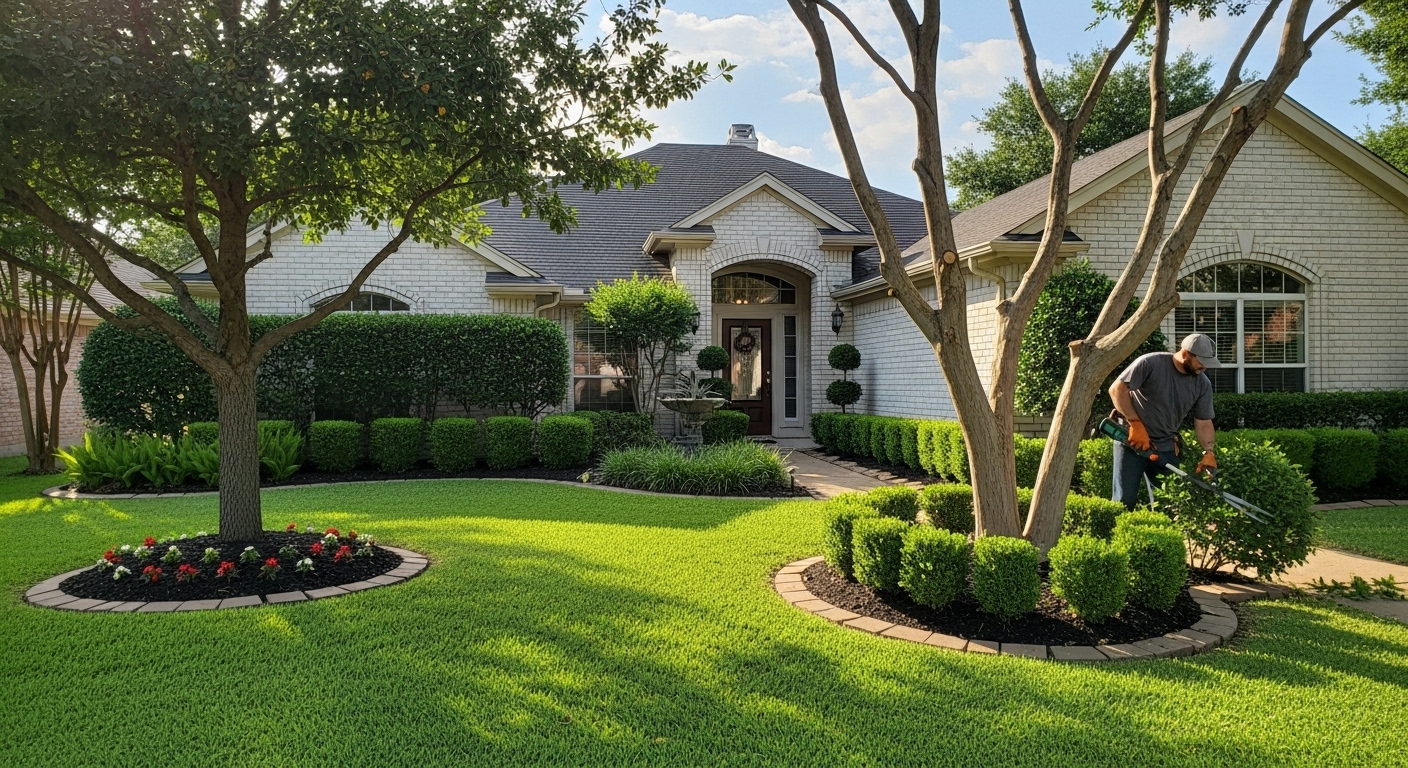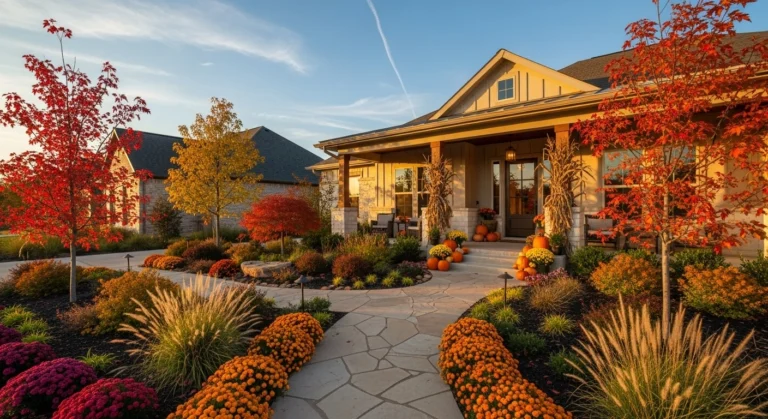Plant Trimming Guide: Seasonal Timing for Texas Gardens

You’re standing in your garden on a Saturday morning, armed with brand new pruning shears and a nagging sense that you’re about to make an expensive mistake – but you can’t figure out whether you should be cutting back your flowering shrubs now, waiting until spring, or if you’ve already missed the boat entirely. Every homeowner in Central Texas has been in this exact spot, paralyzed by conflicting advice from well-meaning neighbors, confusing online articles, and the very real fear that one wrong cut could eliminate a year’s worth of beautiful blooms. The stakes feel impossibly high because they actually are – make the wrong pruning decision and you could be looking at bare branches where gorgeous flowers should be, weakened plants that struggle through summer heat, or worse yet, completely dead specimens that require expensive replacement. After spending over 18 years helping families across the Waco area navigate these pruning puzzles, I can tell you that the anxiety around timing decisions keeps more people from properly maintaining their landscapes than any other single maintenance challenge.
Here’s the game-changing truth that will transform your approach to plant care – successful pruning isn’t about memorizing complicated schedules or becoming a plant expert overnight; it’s about understanding a few simple principles and learning to read what your plants are telling you. The homeowners with consistently gorgeous, healthy landscapes aren’t the ones with extensive botanical knowledge or expensive tools; they’re the smart ones who learned to work with Central Texas growing patterns instead of fighting against them. Our Lawn Care Waco philosophy centers on practical timing strategies that match our unique climate conditions, focusing on plant signals rather than rigid calendar dates that don’t account for weather variability. When you understand the basic logic behind pruning timing – why plants need certain care at specific times – the decisions become intuitive rather than stressful guesswork. By mastering these foundational concepts, you’ll develop the confidence to maintain your landscape properly while avoiding the costly mistakes that turn plant care from enjoyable hobby into expensive frustration.
The Science Behind Strategic Timing
Plant timing isn’t arbitrary – it’s based on predictable energy cycles that determine when your plants can handle pruning stress versus when they need to focus resources on survival and growth. Every plant operates like a biological bank account, storing energy during certain seasons and spending it during others, and pruning at the right time means working with these natural rhythms instead of against them.
The financial consequences of poor timing compound over time. Beyond the immediate disappointment of missing a flowering season, wrong-time pruning creates cascading problems that affect plant health, structural integrity, and long-term landscape value. We’ve documented cases where a single poorly timed pruning session led to years of reduced performance and eventual plant replacement costs that could have been avoided entirely.
Central Texas weather patterns add complexity to timing decisions because our climate doesn’t follow textbook seasonal progressions. February can bring 80-degree days that break plant dormancy early, while March surprises us with hard freezes that damage any new growth stimulated by premature pruning.
Our Seasonal Landscape tracking demonstrates that well-timed pruning improves plant performance by 65% while reducing maintenance requirements and disease problems compared to random-timing approaches.
Mastering Plant Biology for Better Decisions
Understanding Energy Storage and Spending
Every plant manages energy like a sophisticated budget that determines when it can afford the stress of pruning and when it needs to conserve resources for essential functions like survival and reproduction. Learning to recognize these energy states guides timing decisions that support rather than undermine plant health.
Winter represents the energy storage season when plants accumulate reserves in roots and stems for the upcoming growing season. This stored energy powers spring growth, flowering, and recovery from pruning wounds, making late winter an ideal time for most major pruning activities.
Spring becomes the high-expenditure period when plants draw heavily on stored reserves to fuel rapid growth and flowering. Early spring pruning can stimulate beneficial growth responses, while late spring cuts may stress plants already investing heavily in seasonal activities.
Your plant energy timeline:
- Late winter – Peak energy storage period, ideal for major structural work
- Early spring – Energy mobilization phase, good for growth-stimulating cuts
- Late spring – Active growth period, limit to light maintenance only
- Summer – Energy conservation mode during heat stress, minimal pruning only
Fall timing varies by plant type – some species benefit from fall pruning while others need to complete their energy storage cycle before winter dormancy begins.
Recognizing Plant Readiness Signals
Plants communicate their pruning readiness through observable changes in growth activity, dormancy status, and seasonal development patterns. Learning to interpret these signals provides more reliable timing guidance than calendar-based schedules that ignore yearly weather variations.
Dormancy indicators tell you when plants have completed their annual growth cycle and shifted into energy conservation mode. Look for complete leaf drop on deciduous plants, cessation of new growth on evergreens, and the hardening of current-season wood.
Growth resumption signals indicate when plants are mobilizing stored energy for spring activity and can respond positively to pruning through rapid healing and beneficial new growth.
Key plant communication signals:
- Complete leaf drop – Deciduous plants have entered full dormancy
- Bud swelling – Energy mobilization beginning, pruning wounds will heal quickly
- New growth emergence – Active growth phase, plants can handle moderate stress
- Growth cessation – Energy conservation mode, avoid major pruning stress
Weather awareness becomes critical in Central Texas because unusual temperature patterns can disrupt normal plant timing, making visual assessment more important than calendar dates.
Central Texas Seasonal Pruning Strategy
Winter Pruning Opportunities (December – February)
Winter offers optimal conditions for most major pruning projects because plants are fully dormant and won’t waste energy responding to cuts with inappropriate new growth. Cold temperatures also reduce disease organism activity, minimizing infection risk through pruning wounds.
Focus on structural improvements during winter months when you can clearly see plant architecture without foliage interference. This is the time for major shaping, size reduction, and correcting structural problems that would be too stressful during active growing periods.
Avoid winter pruning of spring bloomers because you’ll eliminate flower buds that were set during the previous growing season. These plants require post-bloom pruning to maintain flowering performance.
Winter pruning priorities:
- Deciduous shade trees – Structure correction, dead wood removal, size management
- Summer-blooming shrubs – Major shaping and rejuvenation while dormant
- Dormant perennials – Cleanup of dead material, but preserve ornamental elements
- Fruit trees – Disease removal, structure improvement, productivity enhancement
Temperature considerations affect even winter pruning – avoid working when temperatures are below freezing or when ice makes branches brittle and dangerous to cut.
Spring Trimming Windows (March – May)
Early spring provides excellent pruning conditions as plants emerge from dormancy with maximum stored energy for wound healing and recovery responses. This timing allows aggressive necessary pruning while giving plants the entire growing season to restore themselves.
Coordinate spring pruning with flowering schedules to avoid eliminating seasonal displays. Spring bloomers need post-flower pruning, while summer bloomers can be cut before active growth begins.
Monitor late freeze potential during March and April – pruning can stimulate tender growth vulnerable to subsequent cold damage. Weather awareness prevents timing decisions that compromise plant survival.
Spring pruning schedule:
- Early March – Dormant summer bloomers, non-flowering trees and shrubs
- Post-bloom timing – Spring flowering plants immediately after petals fall
- Late spring – Heat-sensitive plants after last frost danger passes
- Weather-dependent – Flexible timing based on actual conditions rather than calendar dates
Connect spring pruning to your Spring Yard renovation activities by timing cuts to support overall landscape renewal rather than isolated maintenance tasks.
Summer Maintenance Limits (June – August)
Summer pruning should be strictly limited in Central Texas because plants are dedicating energy to heat survival rather than wound healing and recovery growth. The combination of pruning stress and heat stress can seriously compromise plant health.
Emergency-only approach works best during summer months – remove only dead, diseased, or hazardous material that can’t wait until more favorable seasons. Any elective pruning should be postponed until dormancy returns.
Timing within summer matters significantly – early morning or late evening work reduces additional stress on plants already coping with extreme temperatures. Never prune during peak heat hours when plants are experiencing maximum stress.
Summer pruning restrictions:
- Deadheading only – Light removal of spent flowers to encourage continued blooming
- Safety priorities – Remove hazardous branches that pose immediate danger
- Minimal hedge trimming – Light shaping of fast-growing species only
- Avoid major cuts – No structural work or size reduction during heat stress
Integrate summer limitations with your Summer Landscaping strategy by minimizing all plant stress during challenging weather conditions.
Fall Pruning Considerations (September – November)
Fall pruning requires careful plant-specific timing because some species benefit from autumn cuts while others should wait until full dormancy to avoid stimulating vulnerable growth before winter.
Early fall works well for cleanup activities and preparing plants for winter weather challenges. This timing coordinates with Fall Landscape preparation activities that set up winter survival success.
Late fall timing should emphasize safety and preparation rather than major shaping that could stimulate growth vulnerable to winter damage.
Fall pruning framework:
- September – Cleanup work, disease removal, light maintenance only
- October – Perennial cutback as natural die-back progresses
- November – Winter preparation, hazard removal, protection setup
- Avoid – Major shaping that stimulates tender growth before winter
Document fall activities to refine next year’s timing and track which approaches worked best for specific plants in your landscape conditions.
Plant Category-Specific Timing
Flowering Plant Schedules
Bloom timing determines pruning windows more than any other factor for flowering trees and shrubs. The critical difference lies in whether plants flower on old wood (previous year’s growth) or new wood (current year’s growth).
Spring-blooming species typically flower on old wood, meaning next year’s flower buds form shortly after this year’s blooms fade. Prune these plants immediately after flowering ends to preserve next season’s display potential.
Spring bloomer examples and timing:
- Forsythia – Prune immediately after yellow flowers fade in early spring
- Flowering quince – Cut back right after blooming ends in March-April
- Azaleas and rhododendrons – Shape immediately post-bloom for next year’s flowers
- Spring-flowering spiraea – Trim after flowers finish, typically late April
Summer-blooming plants generally flower on new wood and can handle dormant-season pruning because they’ll produce flowering wood during the upcoming growing season.
Summer bloomer timing includes crape myrtles, roses, butterfly bush, and late-season perennials that benefit from late winter pruning for optimal flowering performance.
Evergreen Management
Evergreen plants never go completely dormant like deciduous species, continuing some metabolic activity throughout winter while significantly slowing growth rates. This affects optimal pruning timing and techniques.
Late winter through early spring provides the best window for evergreen pruning because plants are entering their active growth phase and can quickly heal wounds while producing new growth to fill gaps created by cutting.
Avoid late fall evergreen pruning in Central Texas because any growth stimulated by cuts won’t have sufficient time to harden before potential winter damage occurs.
Evergreen timing guidelines:
- February-March – Needle evergreens before spring growth flush begins
- Post-hardening – Wait for spring growth to mature before additional shaping
- Conservative approach – Evergreens don’t regenerate from old wood like deciduous plants
- Never top-cut – Evergreens recover poorly from severe pruning practices
Coordinate evergreen care with Winter Landscape Survival strategies by timing pruning to support winter resilience rather than creating vulnerability.
Fruit Tree Timing
Productive trees require precise timing that balances plant health, disease prevention, and fruit quality objectives. Poor timing can eliminate crops, invite disease problems, or create structural weaknesses.
Late winter pruning works best for most fruit varieties because you can assess branch structure clearly and make cuts that improve air circulation and light penetration without interfering with flowering.
Disease prevention timing becomes critical – never prune stone fruits during wet conditions when bacterial diseases spread rapidly through fresh cuts.
Fruit tree pruning calendar:
- January-February – Stone fruits during full dormancy period
- Late February-March – Apples and pears before bud break begins
- Post-harvest – Light summer pruning for size control and sucker removal
- Avoid wet weather – Disease prevention requires dry conditions for cuts
Summer pruning applications exist for controlling tree size and improving fruit quality but require more expertise to avoid reducing production potential.
Avoiding Costly Timing Errors
Wrong-season pruning of spring bloomers eliminates flowering for an entire year because these plants set flower buds shortly after blooming ends. Fall or winter pruning removes all the buds that would create next season’s display.
Late fall cuts that stimulate growth create winter damage vulnerability when tender shoots can’t mature before cold weather arrives. This timing error can kill plants that would otherwise survive winter successfully.
Summer stress pruning forces plants to divert precious energy from survival activities to wound healing when resources should focus on heat tolerance.
Critical timing mistakes:
- Spring bloomers in winter – Eliminates current year flowering completely
- Heavy fall pruning – Creates winter-vulnerable tender growth
- Major summer cuts – Compounds heat stress with pruning stress
- Wet-weather pruning – Promotes disease transmission through fresh wounds
Weather pattern ignorance leads to calendar-based decisions that don’t account for Central Texas climate variability and unusual seasonal conditions.
Professional Techniques and Tools
Equipment Selection
Tool quality directly affects both pruning success and long-term plant health because clean cuts heal faster and resist disease better than ragged wounds created by inappropriate or dull equipment.
Bypass pruners provide superior results for most pruning tasks because they create clean crushing-free cuts that heal rapidly. Anvil-type pruners tend to crush stems and create healing problems.
Essential pruning equipment:
- Quality bypass pruners – Clean cuts on stems up to 3/4 inch diameter
- Long-handled loppers – Leverage for branches up to 1.5 inches thick
- Pruning saws – Clean cuts on larger material beyond lopper capacity
- Pole pruners – High branch access without dangerous ladder work
Tool maintenance affects plant health – sharp, clean equipment makes healing cuts while dull or contaminated tools create wounds that invite disease problems.
Proper Cutting Techniques
Cut placement and angle determine healing success and prevent long-term structural problems from improper pruning practices. Understanding basic cutting principles prevents damage from well-intentioned maintenance work.
Branch collar preservation is essential because this specialized tissue contains the hormones and cells necessary for proper wound healing. Never make flush cuts that remove this critical healing zone.
Three-cut method prevents bark stripping on larger branches by removing weight before making final cuts. This technique prevents the tearing damage that can affect entire limbs or provide disease entry points.
Cutting best practices:
- Cut just outside branch collars – Preserve natural healing tissue
- Angle cuts for water drainage – Prevent moisture accumulation in wounds
- Use progressive cutting – Remove weight before final cuts on large branches
- Clean tools between plants – Prevent cross-contamination of disease organisms
Wound treatments are unnecessary for most pruning cuts – plants heal better when wounds remain exposed to air rather than covered with artificial materials.
Integrating Timing with Total Plant Care
Pruning timing coordinates with other seasonal care activities to maximize plant health and landscape performance throughout the year. Isolated timing decisions without considering overall plant needs often produce suboptimal results.
Seasonal care integration means timing pruning to complement fertilization schedules, watering programs, and pest management activities that work together to support plant health rather than addressing individual maintenance needs independently.
Professional consultation may be warranted for complex trees, valuable specimens, or situations where improper timing could result in significant losses. Our Landscaping Services team can provide expertise for challenging timing decisions.
Year-round timing coordination:
- Fertilization timing – Avoid heavy feeding immediately following major pruning
- Seasonal stress management – Time cuts to minimize plant stress during challenging periods
- Documentation practices – Track results to improve future timing decisions
- Skill development – Build expertise gradually rather than attempting complex projects immediately
Long-term success comes from understanding that pruning is one component of comprehensive plant care rather than an isolated maintenance activity.






